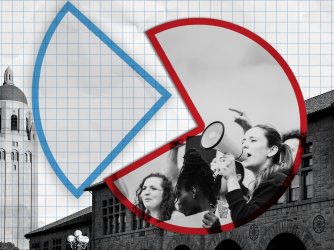Table of Contents
Survey: Student affairs officers have rosier perception of campus expression climate than students

Inside Higher Ed last week released its first ever survey of college and university student affairs officers, which included questions on the state of campus expression. This is an important survey because student affairs officers are more likely to have direct interaction with students than provosts or presidents, who are routinely surveyed by Inside Higher Ed. The survey’s findings suggest that although they believe there still is room for improvement, student affairs officers generally think that the students on their campus feel able to freely express their opinions and are treated well on campus — even if students don’t feel the same way.
Among the 506 student affairs officers who fully or partially completed the survey:
- Almost 8 in 10 (78%) reported that their college or university’s campus was an “excellent” (22%) or “good” (56%) place for students to express their ideas and opinions freely.
- Majorities, when asked about how well 14 different student groups are treated on their campus, reported that each student group was treated “very well” or “well.” The percentage of student affairs officers reporting this ranged from a high of 97% who said white students were well-treated to a low of 57% who believed that black students were well-treated.
A 2018 Inside Higher Ed survey of chief academic officers revealed that provosts perceived the expression climate on their campuses to be even stronger. Among the 516 chief academic officers surveyed:
- More than 9 in 10 (94%) reported that white students generally feel welcome in classrooms on their campus; 70% reported that racial and ethnic minority students felt welcome.
- More than 8 in 10 (84%) reported that liberal students generally feel welcome in classrooms on their campus; 68% reported that conservative students feel welcome.
Yet when comparing these findings to national and campus-specific surveys assessing student perceptions that were conducted over the past few years, a different picture emerges. Although the questions that students were asked were different from the questions asked of student affairs officers and chief academic officers, a number of national and campus-specific surveys have asked students if they agree or disagree that the climate on their campus prevents some people from saying what they believe because others may find it offensive.
As can be seen in the figure below, in each of four national surveys conducted since 2016, a majority of students reported that the climate on their campuses prevents people from saying what they believe because others might find them offensive.
On the individual campuses surveyed, student responses varied. At Dartmouth College and Pomona College, an overwhelming majority of the students surveyed reported that the climate on their campuses prevents some people from expressing their views. In contrast, the majority of students enrolled in the University of Nebraska system, which is made up of four different campuses, reported a much stronger campus expression climate. Response rates for these campus specific surveys among the students ranged from a low of 9% for students enrolled in the University of Nebraska system to a high of 35% for students enrolled at Pomona College.
In sum, with the exception of the students surveyed from the University of Nebraska system, a majority of students in national samples and campus-specific samples reported that the climates on their campuses, to an extent, can chill speech. These findings conflict with how student affairs officers perceive the campus expression climate.
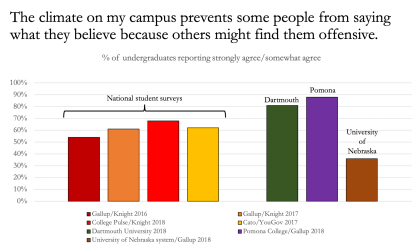
Other national student surveys also paint a picture that differs from administrator perceptions. Since the fall of 2015, The William F. Buckley Jr. Program at Yale has partnered with McLaughlin and Associates to conduct an annual national survey of college undergraduates.
In each of these surveys, students have been asked two items about expressing their views in the classroom:
- Have you ever felt intimidated sharing your ideas, opinions, or beliefs in class because they were different than those of your professors?
- Have you ever felt intimidated sharing your ideas, opinions, or beliefs in class because they were different than those of your classmates or peers?
As can be seen in the figure below, each year roughly half of the students surveyed have reported feeling “frequently” or “sometimes” intimidated sharing ideas, opinions, or beliefs in class that were different from those of their professors or their peers. Consistent with the other student surveys above, the findings from the Buckley surveys suggest that a notable portion of students may feel intimidated sharing their ideas, opinions, and beliefs in the classroom. Once again, these findings on student perceptions conflict with the findings on how student affairs officers perceive the campus expression climate.
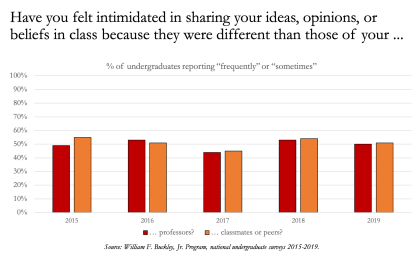
Furthermore, when considering gender, race/ethnicity, and political affiliation a majority of students reported feeling intimidated in the classroom because their views differed from those of their professor or their classmates, findings that again conflict with the perceptions of student affairs officers and chief academic officers, who reported that majorities in all student groups are treated well on campus and feel welcome in the classroom:
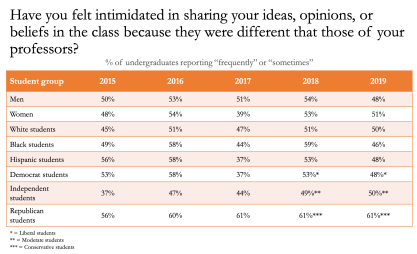
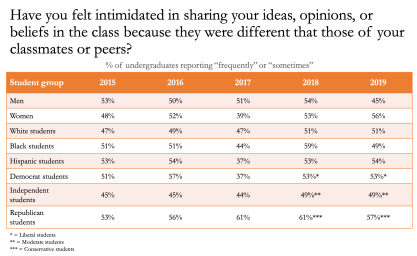
In sum, the perceptions that student affairs officers and chief academic officers have of the campus expression climate differ from those of students. Both groups of administrators appear to perceive that the climate for free expression on their campuses is strong, and that students feel free to voice their beliefs, ideas, and opinions on campus and in the classroom. The student data, in contrast, paints a murkier picture. A substantial number of students perceive a chilled climate for expression - one in which they may need to self-censor their beliefs, ideas, and opinions because they differ from those of their professors and peers.
All of these data have the potential to help administrators, faculty, students, and outside groups obtain a better picture of the campus expression climate. However, the current data that are available come from a handful of national surveys and a few campus-specific ones. If college and university stakeholders want to better understand how administrators and students perceive and experience the campus expression climate, both nationally and on individual campuses, more information will be needed so that we may better analyze how attitudes about free speech may be changing on campus.
Recent Articles
FIRE’s award-winning Newsdesk covers the free speech news you need to stay informed.

BREAKING: New Title IX regulations undermine campus free speech and due process rights
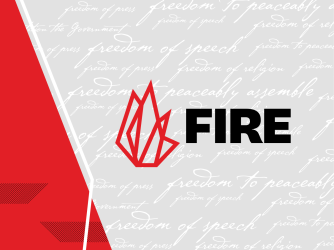

Stanford president and provost cheer free expression in open letter to incoming class
